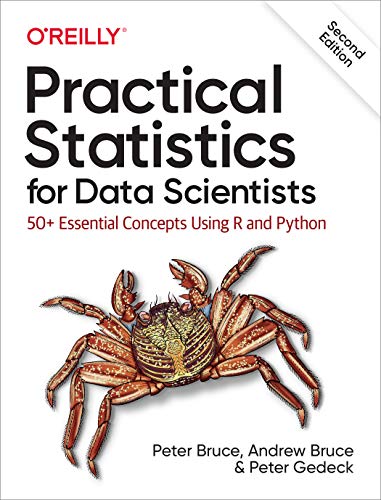
Practical Statistics for Data Scientists: 50+ Essential Concepts Using R and Python
Peter Bruce (Autor), Andrew Bruce (Autor), Peter Gedeck (Autor)
Reading
Read
Favorite
Statistical methods are a key part of data science, yet few data scientists have formal statistical training. Courses and books on basic statistics rarely cover the topic from a data science perspective. The second edition of this popular guide adds comprehensive examples in Python, provides practical guidance on applying statistical methods to data science, tells you how to avoid their misuse, and gives you advice on what’s important and what’s not. Many data science resources incorporate statistical methods but lack a deeper statistical perspective. If you’re familiar with the R or Python programming languages and have some exposure to statistics, this quick reference bridges the gap in an accessible, readable format. With this book, you’ll learn: Why exploratory data analysis is a key preliminary step in data science How random sampling can reduce bias and yield a higher-quality dataset, even with big data How the principles of experimental design yield definitive answers to questions How to use regression to estimate outcomes and detect anomalies Key classification techniques for predicting which categories a record belongs to Statistical machine learning methods that "learn" from data Unsupervised learning methods for extracting meaning from unlabeled data
Detalles del producto
Editorial : O'Reilly Media; N.º 2 edición (29 junio 2020)
Idioma : Inglés
Tapa blanda : 350 páginas
ISBN-10 : 149207294X
ISBN-13 : 978-1492072942
Peso del producto : 612 g
Dimensiones : 17.78 x 2.29 x 23.11 cm
Clasificación en los más vendidos de Amazon: nº89 en Bases de datos y big data
nº122 en Teoría matemática
nº166 en Software y aplicaciones de negocio (Libros)
Opiniones de los clientes: 4,5
827 valoraciones
Editorial : O'Reilly Media; N.º 2 edición (29 junio 2020)
Idioma : Inglés
Tapa blanda : 350 páginas
ISBN-10 : 149207294X
ISBN-13 : 978-1492072942
Peso del producto : 612 g
Dimensiones : 17.78 x 2.29 x 23.11 cm
Clasificación en los más vendidos de Amazon: nº89 en Bases de datos y big data
nº122 en Teoría matemática
nº166 en Software y aplicaciones de negocio (Libros)
Opiniones de los clientes: 4,5
827 valoraciones
When you purchase through links on our site, we may earn an affiliate commission at no cost to you.













